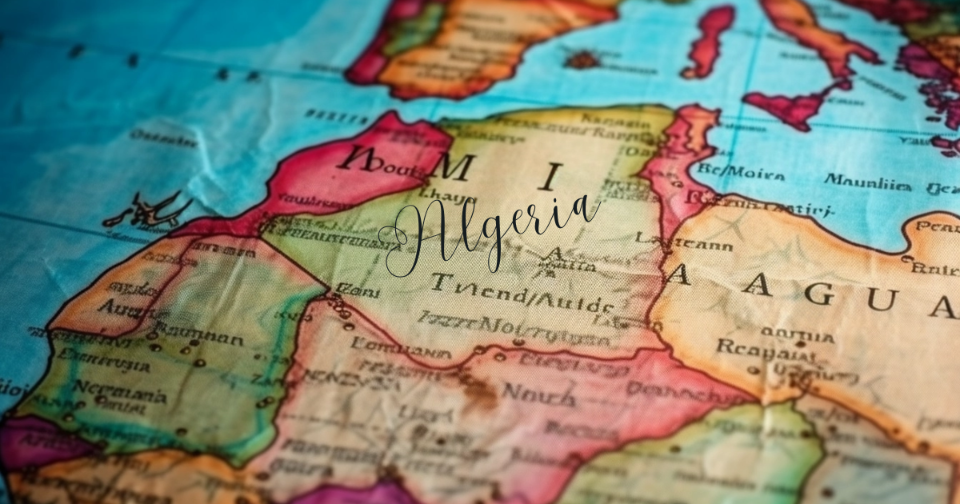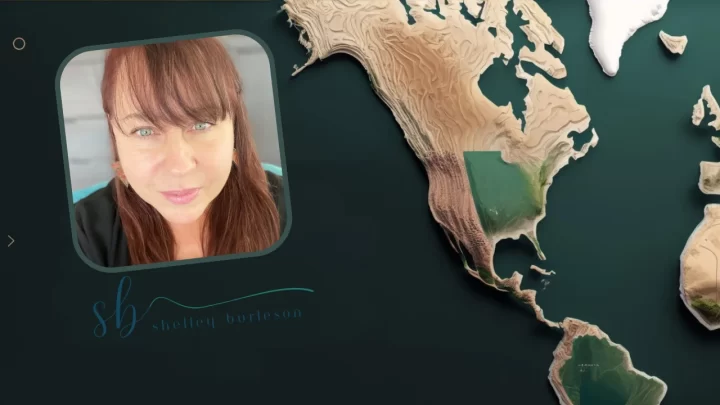This post may contain Amazon affiliate links which means, as an Amazon Associate, I may receive a small commission from purchases made through these links at no cost to you. I only recommend products I have personally used. To learn more, please see my privacy policy page.
Algeria is a country in North Africa, known for being the largest country on the African continent and the 10th largest in the world. Its capital and most populous city is Algiers, located in the northern part of the country along the Mediterranean coast. Algeria shares borders with Tunisia, Libya, Niger, Mali, Mauritania, Western Sahara, and Morocco.
Key Words
- Atlas Mountains
- Berber
- Casbah
- Couscous (link to podcast)
- Ergs
- Fennec Fox
- Hamadas
- Hoggar Mountains
- Maghreb
- M’zab Valley
- Sahara
- Wadis
Join me as we explore each map component and their contribution to the map’s utility and integrity. Learn how the evolution from traditional to digital maps has expanded their capabilities, making them indispensable tools in our daily lives and professional fields. Read on…
Key Takeaways
- Algeria’s landscape is marked by dramatic contrasts, from the lush Mediterranean coast to the sprawling expanse of the Sahara, showcasing the country’s unique geographical diversity.
- Algerian culture evolved from centuries of Arab, Berber, and French influences, creating unique traditions, languages, and architectural styles.
- Algeria’s history is a compelling narrative of transformation, from ancient civilizations and Islamic dynasties to French colonization and the triumphant struggle for independence.
- Key sectors such as hydrocarbons and agriculture play vital roles in Algeria’s economy, highlighting its potential for growth and the ongoing efforts towards diversification and sustainability.
Introduction
Algeria’s history develops from ancient civilizations, through tumultuous periods of colonization, to its triumphant struggle for independence, shaping the modern nation we see today. This journey through time reveals the resilience and cultural richness of the Algerian people, whose heritage is a testament to their enduring spirit and complexity.
Ancient Beginnings: The lands of Algeria have been inhabited for millennia, with prehistoric cave paintings in the Sahara, such as those in Tassili n’Ajjer, serving as a testament to the region’s ancient human presence. These artworks, some dating back over 12,000 years, offer insights into early human life and the environment of the time. The Phoenicians established trading posts along the coast, laying the groundwork for the Mediterranean cultures that would follow. The Romans later annexed these territories, introducing advanced engineering, architecture, and agricultural techniques, remnants of which are visible in the amazing ruins scattered across the country.
Islamic Era and Ottoman Influence: The arrival of Arab Islamic conquerors in the 7th century marked a pivotal shift, introducing Islam, which would become the backbone of Algerian culture and society. The subsequent centuries saw the region under the influence of various Islamic dynasties, including the Fatimids, Almoravids, and Ottomans, each contributing to Algerian Islamic art, science, and architecture. The Ottoman period, in particular, fortified the coastal cities, including Algiers, which became a key center in the Mediterranean.
Colonial Struggle and Independence: The dark chapter of French colonization began in 1830, heralding a period of strife and resistance that would last over a century. Despite attempts at cultural assimilation and the harsh realities of colonial rule, the Algerian spirit of resistance grew, culminating in the bloody war of independence that lasted from 1954 to 1962. The sacrifices of the Algerian people during this period are a poignant reminder of their quest for sovereignty, resulting in independence, and the birth of the modern Algerian state.
Modern Algeria: Since gaining independence, Algeria has navigated the complexities of nation-building, balancing modernization with the preservation of its heritage. The country has made significant strides in education, infrastructure, and economic development, particularly in the hydrocarbon sector. However, challenges remain, including political reform, economic diversification, and social cohesion. Today’s Algeria is a testament to its proud people, who continue to shape their future, drawing strength from their diverse historical experiences.
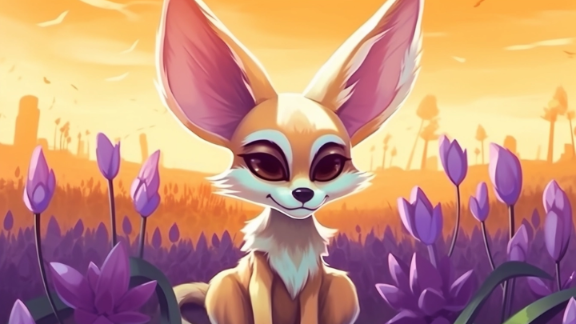
Algeria: National Symbols
As we investigate the geography, landmarks, and people of Algeria, we uncover a country that is not only anchored in its past but also looking forward to a bright future.
Each emblem, from the flag to the wildlife and flora, tells a story of the profound connection between the Algerian people and their land. These symbols are not just representations; they are the essence of Algeria, reflecting its history, values, and aspirations.
The Algerian Flag: The flag of Algeria is a symbol of the country’s identity, history, and values. It features two equal vertical bands of green and white. The green color symbolizes the beauty and verdancy of the land, reflecting Algeria’s agricultural heritage and its Islamic tradition. White represents peace and purity, echoing the aspirations of the Algerian people for a peaceful future. At the flag’s center lies a red, five-pointed star within a crescent, both traditional symbols of Islam, which is the predominant religion in Algeria. The red color of these symbols stands for the blood of those who died fighting for independence from France, making the flag not just a national emblem but a tribute to sacrifice and freedom.
National Animal – the Fennec Fox: The Fennec fox, with its distinctive large ears and petite frame, is the national animal of Algeria. This small nocturnal fox is perfectly adapted to the harsh conditions of the Sahara, symbolizing spirit and ability to thrive in challenging environments. Its large ears serve not only for acute hearing but also to dissipate heat, demonstrating remarkable adaptation to its surroundings. The Fennec fox represents endurance and ingenuity, qualities that have enabled the Algerian people to traverse the complexities of their history and geographical challenges.
National Bird – the Barbary Partridge: The Barbary Partridge holds the esteemed title of Algeria’s national bird. This species, native to North Africa, is admired for its striking appearance and robust nature, thriving in the arid and semi-arid landscapes that characterize much of Algeria. The Barbary Partridge’s presence in Algerian culture and folklore underscores the deep connection between the country’s people and their natural environment. Its ability to adapt to diverse habitats mirrors the spirit of Algeria, making the Barbary Partridge a fitting emblem of the nation’s enduring heritage and ecological diversity..
National Flower – the Iris Tectorum: Although not indigenous to Algeria, the Iris Tectorum, commonly known as the roof iris, has been adopted as a symbol of beauty, purity, and protection. This flower, with its striking appearance and resilience, is often found in varied climates, reflecting the diverse environmental conditions of Algeria. The selection of the Iris Tectorum as the national flower underscores the appreciation of beauty and nature in Algerian culture, as well as the importance of environmental preservation and respect for the natural world.
Together, the flag, national animal, bird, and flower encapsulate the spirit of Algeria’s national identity, embodying the country’s values, resilience, and the beauty of its natural landscapes.

Algeria: Location, Location, Location
Algeria, a land of staggering natural beauty, sits prominently in North Africa, claiming the title of the continent’s largest country. Its vast landscapes stretch from the deep blue waters of the Mediterranean Sea in the north to the sweeping dunes of the Sahara in the south, offering a geography as diverse as it is expansive. Algeria’s strategic position not only makes it a crucial bridge between Africa and Europe but also a central figure in the Maghreb and the broader Arab world. This geographical significance is underscored by its plentiful deposits of oil and natural gas, which position Algeria as a key player in global energy markets. The country’s varied climate zones, from Mediterranean coastlines to desert interiors, further highlight its unique environmental and ecological importance on the African continent.
Neighboring Countries
Algeria is bordered by no less than seven countries, making it a strategic nation in North Africa’s geopolitical landscape. To the northeast lies Tunisia, with which Algeria shares a history of cultural and political ties, underscored by the seamless blend of the Atlas Mountains that traverse both nations. Eastward, the border with Libya stretches across the northern edge of the Sahara, marking a line through one of the most arid regions on earth. To the southeast, Algeria meets Niger, a boundary that descends deep into the heart of the desert, highlighting the challenges of border control and the movement of peoples and goods in such a vast, uninhabited space.
The southern frontier with Mali and Mauritania further emphasizes Algeria’s role as a guardian of vast Saharan territories, where the desert’s expanse dominates the landscape. These borders are not just lines on a map; they are live corridors for trade, cultural exchange, and sometimes conflict, reflecting the complicated relationships that define the region.
To the west, Algeria shares a long and politically contentious border with Western Sahara, a territory with unresolved sovereignty claims that test Algeria’s diplomatic relations and regional politics. The westernmost boundary is with Morocco, a neighbor with which Algeria has a long history but also strained relations due to various political disputes. This border, often closed, shows the complexities and rivalry that define Maghreb politics.
Together, these neighboring countries encircle Algeria, making it a land of both connection and contrast in the heart of North Africa. Its borders illustrate the country’s vital role in the economic, cultural, and political narratives of the region.
Major Cities
Algeria is home to several major cities, each with their own charm and significance. From the busy streets of Algiers to the historic bridges of Constantine, these cities are the heartbeat of the nation.
Algiers: The capital and largest city, Algiers, sits on the edge of the Mediterranean Sea, offering stunning coastal views alongside its urban hustle. Known as the “White City” for its gleaming white buildings that shimmer under the sun, Algiers is the political and cultural hub of Algeria. Its modern cityscape is punctuated by French colonial architecture, bustling markets, and the historic Casbah, a UNESCO World Heritage site that tells tales of ancient empires and pirate legends. Algiers is not just the administrative heart of Algeria but also a melting pot of cultures, reflecting the country’s history and diversity.
Oran: Algeria’s second-largest city, Oran is famed for its musical heritage, particularly Rai music, giving it a fun and upbeat cultural scene. Located on the northwestern Mediterranean coast, Oran boasts beautiful beaches, a lively waterfront, and architectural marvels that span Spanish, French, and Ottoman influences. Its historical sites, like the Fort Santa Cruz and the Great Mosque, offer glimpses into the city’s history, while its modern cafes and theaters reflect a bustling, contemporary lifestyle.
Constantine: Perched dramatically atop a plateau, Constantine is often called the “City of Bridges” due to the spectacular viaducts that span the deep gorges surrounding it. This city is one of the oldest in the world, with a history that stretches back over 2,500 years, offering a wealth of archaeological and architectural treasures. Constantine’s unique topography and historical sites, including the Palace of Ahmed Bey and the ancient ruins of Tiddis, make it a fascinating destination for those interested in history and natural beauty.
Annaba: Lying in the northeastern corner of Algeria, Annaba is known for its lush landscapes and beautiful coastline, including the renowned beaches of Seraidi. It combines the charm of a coastal town with historical heritage, home to the Basilica of St Augustine, which overlooks the city from a hilltop. Annaba’s economic life is vibrant, with its port playing a critical role in regional trade. The city’s blend of beautiful beaches, historical sites, and industrial prowess make it a unique Algerian treasure.
Together, these cities form the backbone of Algeria’s urban landscape, each contributing its own flavors, traditions, and histories to the diversity of the nation. They offer a comprehensive view of Algeria’s past and present, from ancient ruins and historical battles to modern-day cultural and economic dynamism.
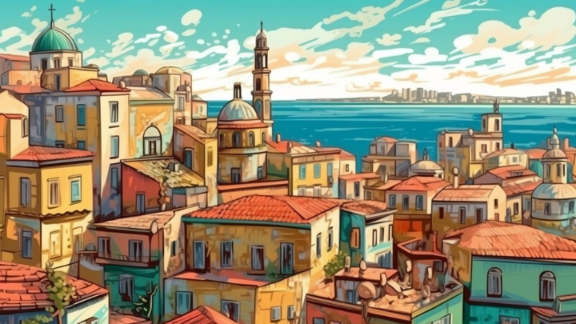
Capital City Spotlight: Algiers
Algiers, the capital city of Algeria, stands nestled along the Mediterranean coastline, and is affectionately known as “El-Djazaïr” (rocky islands) in Arabic and sometimes referred to as the “White City” for its dazzling white buildings that gleam against the backdrop of the sea and sky. Its strategic location has made it a significant Mediterranean port, bridging Africa with Europe and serving as a crossroads of cultures, commerce, and history.
History: Algiers’ history is as complicated as the winding streets of its Casbah. Founded by the Phoenicians in the 4th century BC, it later became a small Roman town before falling under the control of various dynasties and empires, including the Byzantines, Umayyads, and Ottomans. The city’s modern identity was significantly shaped during the French colonial period, starting in 1830, which introduced European architectural styles and urban planning, yet also sparked resistance that culminated in Algeria’s fight for independence. The Casbah, a historic area within Algiers, is a UNESCO World Heritage site and symbolizes the city’s resistance against French colonialism, culminating in Algeria’s independence in 1962.
Geography: Algiers is uniquely positioned, with the Mediterranean Sea to the north and a range of hills to the south, offering both urban charm and natural beauty. This geographical diversity allows for a mild Mediterranean climate, with warm summers and mild, wet winters, making Algiers a year-round destination for visitors and a pleasant habitat for its residents.
Cultural Sites: The city is a cultural center, boasting a mix of modern Algerian life, colonial legacy, and ancient heritage. The Casbah, a maze of narrow alleys and traditional houses, is the heart of Algiers’ historical and cultural identity. Notable sites within and around Algiers include the Notre Dame d’Afrique, a 19th-century basilica that overlooks the bay; the Martyrs’ Memorial, commemorating the Algerian struggle for independence; and the Bardo National Museum of Prehistory and Ethnography, housing artifacts that tell the story of Algeria’s history and diverse cultures.
Role as the Political and Cultural Heart: As the capital, Algiers is the political epicenter of Algeria, hosting the nation’s government institutions, foreign embassies, and the headquarters of many national and international organizations. It is also a cultural hub, home to numerous festivals, art galleries, theaters, and libraries that celebrate Algerian and Maghreb culture. The city’s universities and research institutions contribute to its status as a center for education and innovation in the region.
Algiers’ blend of historical depth, cultural richness, and geopolitical significance makes it not just the administrative capital of Algeria but also the symbolic heart of the nation. It is a city where the past and present coalesce, offering insights into Algeria’s journey through time and its aspirations for the future.
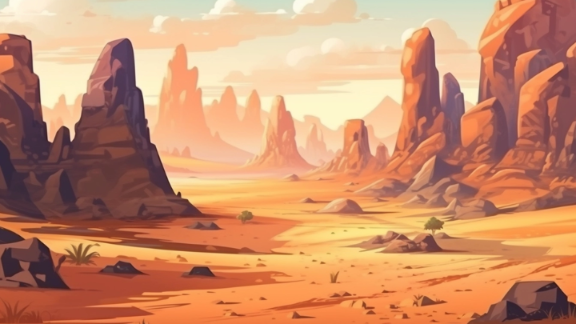
Algeria: Physical Geography
Landforms
Algeria’s vast territory encompasses some of the most striking and diverse landforms in North Africa, from the sweeping expanse of the Sahara to the towering peaks of the Atlas and Hoggar Mountains to the fertile coastal plains. These geographic features not only shape the country’s natural landscapes but also influence its climate, biodiversity, and human activities.
The Sahara: Covering a significant portion of Algeria, the Sahara is the largest hot desert in the world. This vast arid expanse is characterized by its sand dunes, rock formations, and sparse vegetation. The Sahara’s beauty is stark and mesmerizing, with landscapes that change from vast sand seas (ergs) to rugged stone plateaus (hamadas) and deep, narrow valleys (wadis). Despite its harsh conditions, the Sahara is home to nomadic communities who have adapted to life in this extreme environment, and it contains significant oil and natural gas reserves that are crucial to Algeria’s economy.
Atlas Mountains: The Atlas Mountains stretch across northern Africa, with their northern range running through Algeria and providing a natural barrier between the Mediterranean and the Sahara. These mountains are not just a significant geographical feature but also a biodiversity hotspot, offering a range of ecosystems from lush forests in the wetter northern slopes to semi-arid areas on the southern edges. The Atlas Mountains are vital for agriculture, as they capture moisture from the Mediterranean, creating fertile valleys known for olive groves and vineyards. These mountains also play an important role in the cultural and social lives of the Berber communities who have inhabited these regions for centuries.
Hoggar Mountains: Situated in the central Sahara, the Hoggar Mountains rise dramatically above the desert landscape. This rugged mountain range is characterized by volcanic peaks, with Mount Tahat being the highest point in Algeria. The Hoggar Mountains are known for their dramatic scenery, ancient rock art, and unique geological formations. They serve as a refuge for various species adapted to the desert environment and are an important center of Berber culture, particularly the Tuareg nomads who have long traversed these lands.
Coastal Plains: Contrasting sharply with the arid interior, Algeria’s coastal plains offer lush, fertile lands along the Mediterranean coast. These plains support a rich agricultural industry, including the cultivation of citrus fruits, olives, and vegetables. The coastal region is also where the majority of Algeria’s population resides, with major cities like Algiers, Oran, and Annaba situated along the coast. This area is characterized by a Mediterranean climate, with mild, wet winters and hot, dry summers, making it an important economic and cultural hub for the country.
Together, these landforms present details of natural beauty and geographic diversity that defines Algeria. They influence the climate, dictate the patterns of human settlement, and shape the economic activities of the country, underscoring the deep connection between the Algerian people and their land.
Natural Resources
Algeria’s wealth in natural resources has played a pivotal role in shaping its economy, society, and position on the global stage. The country is endowed with significant oil and gas reserves, a variety of minerals, and a burgeoning potential for renewable energy, making it a key player in the energy sector.
Oil and Gas Reserves: Algeria stands as one of the leading suppliers of natural gas and oil in the world, with its vast reserves concentrated in the Sahara. The country ranks among the top in Africa for oil reserves and is a major gas exporter, particularly to Europe. The hydrocarbon sector is the backbone of the Algerian economy, providing the majority of government revenues and export earnings. The Hassi Messaoud oil field, along with the Hassi R’Mel gas field, are among the largest and most productive fields, underscoring the country’s prominence in the global energy market.
Minerals: Beyond hydrocarbons, Algeria is rich in a variety of minerals. The country has significant deposits of iron ore, phosphates, zinc, mercury, and uranium. The mining sector, though less developed than oil and gas, offers substantial growth potential. The phosphate deposits, in particular, are among the largest in the world and represent a significant asset for Algeria’s future economic development, given the global demand for phosphates in agriculture as fertilizer.
Renewable Energy Potential: Algeria’s geographical diversity and climatic conditions present considerable potential for the development of renewable energy sources, especially solar and wind power. The Sahara, with its vast, sun-drenched expanses, offers an ideal setting for solar energy production. The government has recognized this potential and has begun to invest in renewable energy projects to diversify its energy sources and reduce reliance on fossil fuels. The goal is not only to meet domestic energy needs more sustainably but also to become a leader in renewable energy in the region.
The natural resources of Algeria are a critical asset, driving the country’s economic engine and offering pathways to sustainable development. The challenge and opportunity for Algeria lie in managing these resources effectively, ensuring environmental protection, and diversifying its economy to reduce dependency on hydrocarbons. With strategic investments in renewable energy and sustainable mining practices, Algeria can harness its natural wealth for long-term prosperity and environmental stewardship.
Climate and Weather
Algeria encompasses a wide range of climate zones, reflecting the country’s diverse geography from the lush Mediterranean coast to the arid expanses of the Sahara. This diversity in climate zones significantly influences the country’s environmental conditions, agricultural practices, and daily life.
Mediterranean Coast: Along the northern edge of Algeria, the Mediterranean coast enjoys a temperate climate characterized by mild, wet winters and hot, dry summers. This climate zone supports a rich agricultural tradition, with olive groves, vineyards, and citrus farms thriving in the fertile soils. The mild climate also makes cities along the coast, such as Algiers, Oran, and Annaba, popular destinations for both tourists and residents seeking a pleasant maritime environment.
Tell Atlas and Saharan Atlas: The Tell Atlas and Saharan Atlas Mountain ranges experience a more varied climate, acting as a transitional zone between the Mediterranean north and the Saharan south. In these regions, temperatures can fluctuate more dramatically, with cooler conditions in the higher elevations and occasional snowfall in the winter. The mountains capture moisture from the Mediterranean, creating microclimates that support diverse flora and fauna and allow for agriculture in valley areas.
High Plateaus: Between the two mountain ranges lie the High Plateaus (Hauts Plateaux), a semi-arid region characterized by extreme temperature variations between summer and winter. This area can experience cold winters with occasional frost and hot, dry summers. Rainfall is sparser and more unpredictable than in the coastal region, limiting the scope of agriculture but supporting hardy cereals like barley and wheat, along with grazing for livestock.
The Sahara: The Sahara dominates the southern 80% part of Algeria, defining the climate of this region with extreme aridity and minimal rainfall. Daytime temperatures can soar, especially in the summer, while nights can be surprisingly cold due to the desert’s lack of humidity to retain the day’s heat. Vegetation is sparse, limited to areas where underground water sources are, such as oases. The Sahara’s climate poses significant challenges to habitation and travel, yet its mesmerizing landscapes and unique ecosystems attract adventurous visitors and researchers.
Climate Change Impacts: Climate change is increasingly affecting Algeria’s diverse climate zones, with rising temperatures, shifting precipitation patterns, and more frequent extreme weather events. These changes pose challenges to water resources, agriculture, and the overall ecological balance, underscoring the need for sustainable management practices and adaptive strategies to mitigate the impacts of climate variability across the country’s distinct regions.
Algeria’s climate and weather patterns are as diverse as its landscapes, offering a study in contrasts that reflect the country’s environmental and cultural geography. Understanding these patterns is crucial for managing the nation’s natural resources, preserving its ecosystems, and planning for the future in the face of global climate challenges.
Natural Hazards
Algeria faces several natural hazards that pose challenges to its development and the well-being of its people. Earthquakes, floods, and desertification are among the most significant hazards, each affecting the country in unique ways.
Earthquakes: Algeria is situated in a seismically active region, particularly along the northern boundary where the African Plate meets the Eurasian Plate. This geological setting makes the country prone to earthquakes, which can cause significant loss of life and damage to infrastructure. The northern coastal regions and areas along the Tell Atlas Mountains are especially vulnerable. Historical earthquakes, such as the 2003 Boumerdès quake near Algiers, underscore the need for effective disaster preparedness and resilient infrastructure to mitigate the impact of such events.
Floods: Despite its predominantly arid climate, Algeria experiences seasonal floods, especially in the northern regions where intense rainfall can occur. Urban areas with inadequate drainage and regions with steep topography are particularly at risk. These floods can lead to loss of life, damage to property, and destruction of crops, compounding the challenges faced by communities. Efforts to improve water management and urban planning are crucial to reducing the vulnerability of affected regions.
Desertification: Desertification poses a significant environmental challenge in Algeria, particularly in the Saharan and Sahel regions. Overgrazing, deforestation, and unsustainable land use practices, combined with climate change, are contributing to the expansion of desert landscapes into previously arable lands. This process threatens biodiversity, reduces agricultural productivity, and exacerbates food insecurity. Combatting desertification in Algeria requires integrated approaches that include sustainable land management practices, reforestation projects, and conservation of water resources to preserve the environment and support rural communities.
Addressing these natural hazards is critical for Algeria’s sustainable development. Investments in early warning systems, infrastructure resilience, environmental conservation, and community preparedness can help mitigate the impacts of these challenges, safeguarding the future of the country and its people.
Wildlife and Nature
Algeria’s varied landscapes host a variety of ecosystems, ranging from the lush Mediterranean coastlines to the stark beauty of the Sahara and the rugged terrain of the Atlas and Hoggar Mountains. This diversity of habitats supports a wide array of wildlife and plant species, some of which are endemic to the region, showcasing the country’s natural heritage.
Mediterranean Coastline and Wetlands: The northern coastal and wetland areas of Algeria are teeming with biodiversity. These regions are crucial for migratory birds, providing stopover points on their trans-Saharan journeys. Species such as the flamingo, the purple heron, and various waterfowl find refuge in the wetlands, making these areas important for birdwatching and conservation efforts. The coastal forests and scrublands also support a variety of mammals, reptiles, and unique plant species adapted to the Mediterranean climate.
Sahara Ecosystems: The Sahara, while seemingly inhospitable, is home to an array of species that have adapted to its extreme conditions. The Fennec fox, with its distinctive large ears, is perhaps the most iconic of the Sahara’s inhabitants, alongside the dromedary camel, and various species of reptiles and rodents. Vegetation is sparse but includes resilient species like the date palm and various types of acacias, which provide essential sustenance and shade. The desert also hosts spectacular natural phenomena, such as the flowering of desert plants following rare rainfall events.
Atlas and Hoggar Mountains: The Atlas and Hoggar Mountains offer a different aspect of Algeria’s natural diversity, with higher altitudes supporting distinct flora and fauna. The Barbary macaque, a type of monkey found in the Atlas Mountains, is one of the few primate species native to Africa north of the Sahara. These mountains also harbor a variety of bird species, including the golden eagle and the Barbary partridge, as well as unique plant species that have adapted to the cooler, more moist conditions compared to the surrounding lowlands.
Endemic Species: Algeria boasts several endemic species, particularly in its mountainous regions, where isolation and diverse habitats have led to high levels of speciation. Among these are the Saharan cypress and the Algerian fir, trees that are relics of the wider forests that once covered North Africa. Efforts to conserve these endemic species are crucial for maintaining biodiversity and ecological balance.
The diversity of Algeria’s wildlife and natural landscapes underscores the importance of conservation efforts to protect these ecosystems from threats such as habitat loss, climate change, and overexploitation. Preserving Algeria’s natural heritage is essential for future generations to enjoy and for maintaining the ecological processes that support life across these varied landscapes.
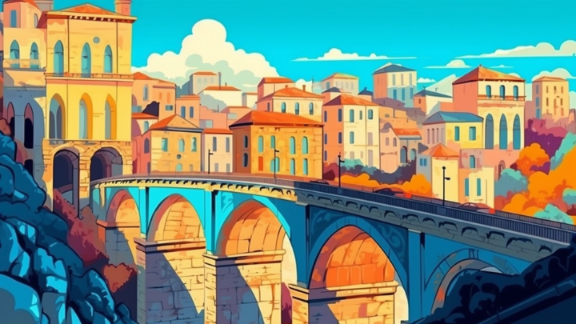
Algeria: Human Geography
Algeria is dotted with landmarks that tell the story of a land at the crossroads of cultures. Among these, UNESCO World Heritage Sites such as Tipaza and other remarkable Roman ruins stand as testaments to Algeria’s ancient past and cultural heritage.
Tipaza: Nestled along the Mediterranean coast, the ancient city of Tipaza is a UNESCO World Heritage site that embodies the fusion of indigenous Berber and Roman civilization. Originally a Punic trading post, it was later transformed into a strategic military colony by the Romans to secure the African frontier. The ruins of Tipaza include a unique ensemble of Phoenician, Roman, early Christian, and Byzantine ruins, alongside indigenous monuments such as the Kbor er Roumia, the great royal mausoleum of Mauritanian kings. The site offers breathtaking views of the sea, and its blend of architectural remains against a picturesque backdrop makes Tipaza a captivating destination for history enthusiasts and nature lovers alike.
Djemila (Cuicul): Situated in the mountainous region northeast of Algiers, Djemila, known in ancient times as Cuicul, is another stunning example of Roman architecture’s adaptability to challenging landscapes. This UNESCO World Heritage site comprises one of the world’s most beautifully preserved Roman ruins. Djemila’s forum, temples, basilicas, triumphal arches, and houses are spread out across a rugged landscape, showcasing the ingenuity of Roman urban planning. The site’s museum houses one of the finest collections of Roman mosaics in Africa, offering insight into the daily lives and artistic achievements of its ancient inhabitants.
Timgad (Thamugadi): Founded by Emperor Trajan around 100 AD as a bulwark against the Berber tribes, Timgad lies on the northern slopes of the Aurès Mountains. It is a quintessential example of Roman town planning, with a rectangular grid of streets, a central forum, a magnificent triumphal arch, and well-preserved public buildings. The city’s library, one of the oldest in the world, speaks to the Romans’ commitment to culture and education. Timgad’s ruins, eloquently silent, tell of the grandeur of Roman civilization and its far-reaching influence.
M’zab Valley: While not Roman, the M’zab Valley is a UNESCO World Heritage site that offers a different but equally fascinating glimpse into Algeria’s architectural and cultural legacy. Founded in the 10th century by the Ibadites around five fortified cities, or ksour, the M’zab Valley is a remarkable example of functional architecture harmoniously integrated with the natural environment to accommodate harsh desert conditions. The valley’s unique, simple, and efficient building style reflects the Ibadi ideals of community living and sustainability, principles that resonate with contemporary architectural and environmental values.
These landmarks, along with Algeria’s other historical and natural sites, are precious treasures of humanity. They not only attract tourists from around the globe but also serve as a continuous reminder of Algeria’s contribution to world culture and history. Protecting and preserving these sites is crucial for future generations to appreciate and learn from the rich history of human civilization that Algeria embodies.
Algerian Culture
Algeria’s cultural geography is a blend of Arab, Berber, and French influences, each contributing to the nation’s identity. This blend of cultures has shaped Algeria’s language, architecture, music, cuisine, and social customs, creating a unique cultural landscape that reflects the country’s complex history and geographical diversity.
Arab Influence: The Arab influence on Algerian culture is profound, dating back to the 7th century with the spread of Islam and Arabic language across North Africa. This influence is most evident in the widespread use of Arabic, Algeria’s official language, and in the Islamic traditions that play a central role in Algerian society. Mosques, such as the Great Mosque of Algiers, stand as architectural symbols of this influence, while religious festivals and practices, like Ramadan and Eid celebrations, mark the rhythm of social life.
Berber Influence: The Berber people, indigenous to North Africa long before the Arab conquest, have left an indelible mark on Algeria’s cultural fabric. Their influence is visible in the Tamazight language, recognized as a national language in Algeria, and in the distinctive Berber music, art, and architecture. Berber villages, particularly in the Kabylie region and the Sahara, maintain traditional lifestyles that reflect a deep connection to the land. The Berber heritage is also celebrated in festivals such as Yennayer, the Amazigh New Year, highlighting the community’s rich history and contributions to Algerian culture.
French Influence: French colonial rule, which lasted from 1830 to 1962, introduced European elements into Algerian culture, leaving a legacy that is both complex and controversial. The French language remains widely spoken and is used in higher education, business, and the media, reflecting the lasting impact of colonization. French architectural styles, cuisine, and fashion have also been woven into the fabric of Algerian society, creating a unique blend of Mediterranean and North African aesthetics. However, the French influence is viewed with ambivalence, as it represents a painful period of struggle for independence and the ongoing process of reclaiming and redefining Algerian identity.
Cultural Synthesis: The interplay of Arab, Berber, and French influences has fostered a dynamic cultural synthesis, making Algeria a place where ancient traditions and modern influences coexist and enrich each other. Algerian literature, cinema, and art reflect this synthesis, drawing on diverse cultural heritages to explore themes of identity, history, and social change. Cuisine is another area of vibrant fusion, where dishes like couscous and tagine are infused with flavors and techniques from across the Mediterranean and the Sahara.
This rich cultural blend is a testament to Algeria’s adaptability, illustrating how diverse influences can coalesce into a cohesive and distinct national culture. Understanding Algeria’s cultural geography offers insight into the complexities of identity and heritage in a rapidly changing world.
Language and Alphabet
Algeria’s linguistic landscape is as complex as its physical geography, dominated by three main languages: Arabic, French, and Berber (Tamazight), each with its own alphabet and historical significance. These languages are not just tools of communication but are deeply embedded in the cultural identity and heritage of the Algerian people.
Arabic: Arabic, the official language of Algeria, is widely spoken and serves as the primary medium of education, government, and media. It arrived in Algeria in the 7th century with the spread of Islam and has since evolved into various dialects across the country. Algerian Arabic, or Darja, is the local dialect, characterized by its unique vocabulary and influences from Berber, French, and other languages. The Arabic script, which is used across the Arab world, is a right-to-left cursive script that has been adapted over the centuries to suit the phonetics and nuances of different Arabic dialects.
Berber (Tamazight): Berber, or Tamazight, refers to the indigenous languages spoken by the Berber communities in Algeria and across North Africa. Recognized as a national language in Algeria, Tamazight encompasses several dialects, such as Kabyle, Chaoui, and Tumzabt, each with its own regional variations. The promotion of Tamazight has been part of a broader effort to preserve and revitalize Berber culture and identity within the Algerian nation.
Tifinagh Alphabet: The Tifinagh alphabet is used to write the various Berber languages, including Tamazight. This script is ancient, with roots that can be traced back to the early Berber and Saharan inscriptions. The modern Tifinagh script is a revival and adaptation of these historical forms, promoted in recent years to preserve Berber linguistic heritage. Unlike the Arabic script, Tifinagh is alphabetic and is written left to right. Its geometric characters are a distinctive feature of Berber cultural expression, appearing in everything from public signage to artistic designs.
Linguistic Diversity and Unity: The coexistence of Arabic and Berber languages in Algeria is a reflection of the country’s complexities. Efforts to promote bilingualism and linguistic rights have been part of Algeria’s broader social and cultural policies, aiming to honor and integrate the rich heritage of all its people. The presence of both the Arabic and Tifinagh alphabets in the public sphere symbolizes a nation that is rooted in its history while looking forward to a future of unity and diversity.
French: The presence of French in Algeria is a significant aspect of the country’s linguistic landscape, stemming from over a century of French colonial rule from 1830 to 1962. Despite the end of colonial rule, the French language has remained an integral part of Algerian society, serving as a secondary language widely used in higher education, the legal system, media, and among the educated elite.
French in Algeria is more than just a remnant of colonial history; it has become a language of business, academia, and international communication. Many Algerians are bilingual or trilingual, fluent in Arabic, Berber, and French, which reflects the country’s complex cultural and historical connections to both the Arab-Islamic world and the West. The use of French has facilitated Algeria’s access to the Francophone world, including economic, educational, and cultural exchanges.
However, the role of French in Algeria is not without controversy. It represents a complex legacy of colonization, with debates surrounding its influence on national identity and the preservation of native languages and cultures. In recent years, there has been a renewed emphasis on promoting Arabic and Berber (Tamazight) languages in an effort to reinforce national identity and heritage. Nonetheless, French continues to play a crucial role in various sectors of Algerian society, indicating the multifaceted nature of Algeria’s linguistic and cultural identity.
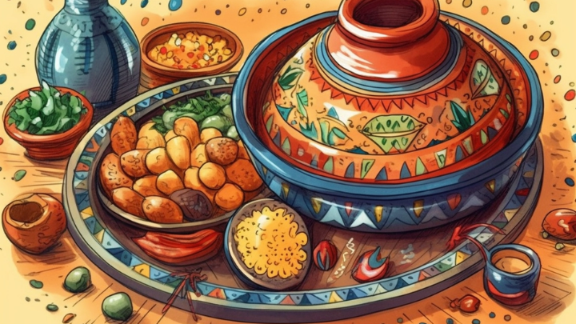
Algeria: Food Traditions
Algerian cuisine is rich in flavors, reflecting the country’s historical and cultural intersections. Traditional dishes like Couscous, Tagine, and Mechoui are central to Algerian culinary traditions, each telling a story of the land, its people, and their celebrations. These dishes, renowned for their depth of flavor and communal preparation, offer a taste of Algeria’s heritage and hospitality.
Couscous: Couscous, often considered the national dish of Algeria, is a versatile staple made from steamed semolina grains. It’s typically served with a stew of meat (lamb, chicken, or beef) and vegetables. The stew is spiced with a blend of herbs and spices unique to North African cuisine, such as cumin, coriander, cinnamon, and saffron, which give it a distinctive flavor.
Tagine: Tagine refers both to the conical clay cooking vessel and the slow-cooked stew that is prepared within it. This beloved dish can include a variety of ingredients, such as lamb, chicken, fish, or vegetables, all simmered with a fragrant array of spices, dried fruits, and nuts.
Mechoui: A celebratory dish, mechoui traditionally consists of a whole lamb slow-roasted over an open fire, seasoned simply with salt, pepper, and sometimes cumin. The result is succulent, fall-off-the-bone meat with a smoky flavor.
These dishes are more than mere meals; they are expressions of Algerian culture, shared around a table with family and friends. Trying these recipes at home can offer a glimpse into the warmth and richness of Algerian hospitality and tradition.
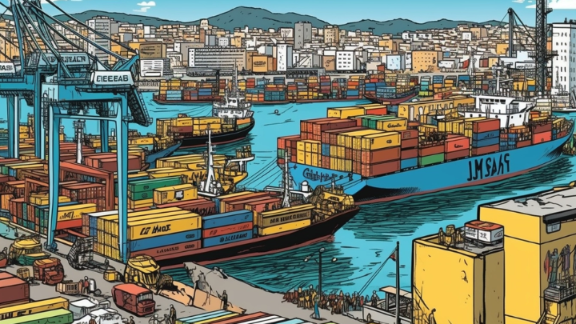
Algeria: Economics
Algeria’s economy, the largest in the Maghreb region, is heavily reliant on its abundant natural resources, which have shaped its development and place in the global market. The country’s economic landscape is dominated by hydrocarbons, agriculture, and an emerging tourism sector, each contributing to its GDP and employment rates. Despite challenges, Algeria is working towards diversification and sustainable growth to ensure long-term economic stability and prosperity.
Hydrocarbons: The backbone of Algeria’s economy is its hydrocarbon sector, which includes oil and natural gas production. Algeria ranks among the top suppliers of natural gas to Europe and is a member of the Organization of the Petroleum Exporting Countries (OPEC). The revenues from oil and gas exports have historically provided the Algerian government with the financial means to invest in infrastructure, social programs, and subsidies for its population. However, the volatility of global oil prices and the increasing global shift towards renewable energy sources have highlighted the need for economic diversification.
Agriculture: Agriculture plays a significant role in Algeria’s economy, employing a substantial portion of the population, especially in rural areas. The sector faces challenges due to limited arable land and water scarcity but remains a crucial part of the economy, producing cereals (such as wheat and barley), olives, dates, citrus fruits, and vegetables. The government has initiated various programs to boost agricultural productivity and sustainability, aiming to reduce dependency on food imports and improve food security.
Challenges and Prospects: Algeria faces economic challenges, including dependency on hydrocarbon revenues, the need for diversification, and addressing unemployment, especially among the youth. The government is taking steps towards economic reform, aiming to encourage foreign investment, develop renewable energy, and promote non-oil sectors such as information technology, manufacturing, and services.
The Algerian economy, with its rich natural resources and strategic location, holds promise for growth and diversification. By leveraging its strengths and addressing its challenges, Algeria can pave the way for a more diversified and sustainable economic future, benefiting both its population and the broader region.
Wrap Up...
Algeria, with its awe-inspiring landscapes, rich history, and vibrant culture, stands as a testament to the resilience and diversity of its people. From the ancient cave paintings of Tassili n’Ajjer to the bustling streets of Algiers, the country encapsulates the essence of human civilization’s enduring spirit. Through centuries of change—from the Berber kingdoms and Roman settlements to the struggle for independence and beyond—Algerians have preserved their identity while adapting to the challenges of each era.
The exploration of Algeria’s geography, from the majestic Sahara to the fertile Mediterranean coast, reveals a land of stark contrasts and natural beauty. Its cities, teeming with life, continue to honor the past while navigating the complexities of modernity. The cultural heritage of Algeria, a blend of Berber, Arab, and French influences, enriches its contemporary identity, offering unique traditions, languages, and arts that reflect the country’s multifaceted history.
Algeria’s journey is not without its challenges, including economic diversification, environmental sustainability, and social cohesion. Yet, the Algerian people’s commitment to progress and unity suggests a promising path forward. The nation’s rich natural resources, strategic geographic position, and, most importantly, its young and dynamic population are key assets in its quest for prosperity and stability.
As Algeria looks to the future, it carries the legacy of its past—not as a burden, but as a foundation upon which to build. The stories of ancient times, the lessons of colonization, and the triumphs of independence are essential elements of Algerian society, contributing to a narrative of hope. For visitors and scholars, Algeria offers a window into the soul of North Africa, inviting exploration, understanding, and admiration.
In concluding our journey through Algeria, we recognize that the true essence of this country lies in its people’s hearts and the landscapes that have shaped their stories. Algeria’s story is one of continuity and change, a reminder of the enduring human capacity to adapt, innovate, and thrive. As we reflect on Algeria’s geography, history, and culture, we are reminded of the universal themes of identity, resistance, and renewal—themes that continue to resonate within and beyond its borders.

